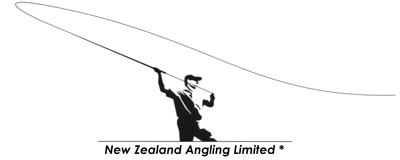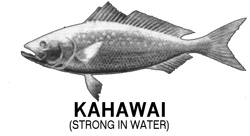| New
Zealand Angling Limited

Submission on the Kahawai Management Proposal

Introduction
New Zealand Angling Limited is a registered company specialising
in designing and promoting fly-fishing events, both fresh and saltwater
flyfishing. Other registered companies in our group are The Kahawai
World Championship Limited, which has International Game Fishing
Association recognition as an I.T.O.C qualifying event, The New
Zealand International Saltfly Tournament that also has IGFA recognition,
and the New Zealand Fly Casting Championships Limited.
Brief History
John Giacon, a Director of the above companies and compiler of this
submission has been involved in the early imposition of catch limits
on recreational anglers in his capacity at the time as President
of the Recreational Fishing Council and of the NZ Federation of
Freshwater Anglers. Since the introduction of recreational limits
we have seen regular reductions imposed in line with restrictions
being made on commercial fishers.
Over the past 10 years, NZ Angling Ltd has pioneered and conducted
saltwater flyfishing events; the first seven of these were ‘All
Species’ events. In the year 2000 we registered and initiated
the Kahawai World Championship event, although it was still part
of the International Saltfly Tournament, it was a simple matter
to segregate the kahawai catch from other species caught.
In 2003 we made the Kahawai World Championship a stand-alone event.
April 2004 will be year two as a stand-alone event, but in fact
we have complete records of kahawai catches over the last four years
and partial records of the kahawai content in the preceding years.
Event Catch Records
Year |
Anglers |
All Species |
Kahawai |
A/S Killed |
K/Killed |
1994 |
24 |
364 |
110 (32%) |
1 |
1 |
1995 |
24 |
648 |
213 (32%) |
1 |
0 |
1996 |
38 |
910 |
318 (35%) |
2 |
1 |
1997 |
52 |
1,625 |
487 (30%) |
4 |
2 |
1998 |
66 |
1,922 |
422 (22%) |
3 |
1 |
1999 |
72 |
2,420 |
677 (28%) |
2 |
1 |
2000 |
78 |
3,450 |
1,345 (39%) |
8 |
3 |
2001 |
48 |
2,100 |
650 (31%) |
2 |
2 |
2002 |
36 |
1,450 |
304 (21%) |
2 |
1 |
2003 |
22 |
620 |
96 (16%) |
1 |
1 |
10 YEARS |
460 RODS |
15,509 A/S |
4,622 (29.80%) |
26** |
13** |
Catch Records Analysis
When you analyse our catch records, please keep in mind that our
event ethic is ‘Catch & Release'. Therefore it is easily
seen that out of a total of 15,509 all species caught only 26 have
been deliberately killed, an outstandingly low 0.16%. Of the 4,622
kahawai caught and recorded only 13 have been deliberately killed,
0.28%.
The reason these fish were killed was for record claiming purposes
where the fish has to be weighed ashore on a set of registered scales
operated by a certified weigh-master. Participants in our events
currently hold 17 world and eight NZ records, mostly in the women’s
records.
You should also note that since the very high year 2000 records
our kahawai to other species percentage has been dropping steadily.
While we can’t show it out of these records, we can state
that the weight of the kahawai has also been dropping steadily,
we estimate from a 2.75 kg average to just under 2 kg over the last
two seasons.
The drop in kahawai numbers being caught are most marked in the
Hauraki Gulf waters where we have ceased our ‘Saltfly Sundays’
programme. The next marked number drop is out of Whangaroa Harbour
in the Far North. The Bay of Islands shows a slight drop in numbers,
but again the weight has been dropping.
A Value Analysis
We concede that we are in a sense a commercial business, however
our intent is to provide a competitive aspect of recreational fishing
and it is under that banner we wish to be recognized. So we can
now divulge some information that will not appear in any records
– what we believe this aspect of our fishing is worth from
a species point of view.
We have indicated that to date 460 people have taken part in our
saltfly events. Add to these about 25% for non-fishing partners,
the ones who don’t compete but do things like sight seeing,
wine trails etc. We know what we charge for our events, most our
overseas participants travel Air NZ thanks to a sponsor support
programme, most hire vehicles for two weeks, a big percentage have
‘add on’ trips, usually a freshwater excursion. Guide,
charter boats, accommodation and meals, gear and equipment, the
alcohol bill is huge! All manner of facilities are required from
doctors to beauty parlours, souvenirs are bought.
So what’s it worth? Well we estimate that as our clients are
50/50 NZ and Overseas, the average cost per person is $3,500.00.
That is about $1,500.00 for locals and about $5,500.00 for overseas.
In 10 years our 575 people involved have spent an average of $3,500.00.
That equates to about a sum of $2,012,500.00. More than two million
dollars, and we believe that estimate is conservative! But more
importantly we can convert that amount to a $130.00 value per fish
caught. That’s per fish! No commercial caught fish can come
within a mile of that.
Better still; if we simply keep kahawai in the equation, then each
kahawai is worth $435.41. That is staggering, especially when you
consider we put all bar 0.28% back and they will be caught again
and their value to the country increase spectacularly. Not so if
they are commercially caught.
Incidentally, we have recorded 37 different NZ saltwater species
have been caught on the fly.
SUBMISSION
We wish to submit that the kahawai is possibly one of the best species
in the world for the sport of fly-fishing. We submit that it is
far too valuable to this country to be subjected to commercial exploitation,
particularly as a quota system is fraught with unknowns. Quotas
can be set, but it is impossible to police them. How many kahawai
do you need to make 100 cans of cat food? Or bags of fertiliser?
Who does the counting anyway? Is it possible to account for all
kahawai caught commercially? Of course not, but it is certainly
much easier in controlled recreational situations.
It is an aim of New Zealand Angling and it’s current directors
to promote kahawai as the preferred saltwater fly rod species for
New Zealand waters. We sincerely believe that pound for pound it
is far superior to trout when using the same fishing gear. Time
after time we have overseas anglers all proclaiming kahawai as a
top game fish. We have professional videos recording these sentiments
from some of the world’s top fly fishers.
There are locations around the world where recreational fly fishing
interests have built up huge industries based on just one species.
Bone fishing in the USA and now in Pacific Ocean islands, permit
in Atlantic seaboard towns, tuna – several species in many
locations including Northern Queensland, of course we have our own
big game industry, so do a great many other countries.
Our point is that in kahawai we have a species common to our waters,
easy access in most locations, a growing cadre of charter boats
and guides keying into what is at present a niche market, but one
that is growing. We have tackle manufacturers and local fly tiers
turning out specific equipment. In short, we have a magnificent
fly-fishing species available in a highly aesthetic environment,
and at present we only have one small company promoting it!
For our part, we will do all in our power to make the public aware
of just what is at stake here, any mismanagement of our kahawai
fisheries will only repeat the mistakes we have seen happen time
and time again where commercial gain is the criteria. We can cite
the orange-roughy fishery, the Chatham Island crayfish fishery,
and our own Hauraki Gulf depletion as prime examples of bureaucracy
overruling common sense. The point is that depleted fisheries seldom
recover even if the breaks are applied. Perhaps we might inquire
about our toheroa and scallop fisheries?
We believe that based on our records and on our observations over
10 years, the kahawai fisheries are showing signs of decline, both
in numbers caught and in weight reduction. We submit there is absolutely
no room for gambling here. Now is the time to put the breaks on,
not after the kahawai species meets the fate of so many other species.
We have seen and been disgusted at watching purse seine methods
wiping out whole schools of kahawai and other species. We submit
that this method has the most lethal effect on numbers available
to the recreational fly fisher and that the weight reduction in
the fish being caught points to commercial catches outstripping
recovery rates. We ask that this method be banned.
We submit that kahawai be totally excluded from commercial quotas
and regulated for as a recreational species only.
We disagree with the MFish calculations on the value of commercially
caught kahawai as against recreational catches. Our evaluation as
previously outlined shows that each recreational fly fishing caught
kahawai has a value of $435 for a 2-kilo fish. That equates to $217.50
per kilo or $217,500 per tonne, nearly four times the MFish estimate.
And if MFish say that the top commercial value is a mere $5,100
per tonne, then surely common sense demands that recreational fishing
for this species must be encouraged, not hindered by allowing commercial
fishers to further plunder the resource.
We strongly support the option4 contentions on matters MFish must
face up to so that the recreational kahawai fishery is enhanced.
We have no objections on limit bags for recreational fishers provided
they are not reduced so as to enhance commercial catches.
For our part we will continue to make sure the ‘Catch &
Release' ethic is encouraged in all our promotions.
We are positive that our Government, MFish, Commercial fishing entities
and business’, and indeed many recreational organisations
still have no idea of the tremendous potential kahawai have to the
economy of this country as a recreational species.
There are so many avenues a fully developed kahawai recreational
fishery will benefit New Zealand and our community. Tourism, accommodation,
service, hospitality, charter, rentals, guides, tackle, manufacturers
and retail must become involved. It is happening, albeit far too
slowly. It is a win-win situation provided it is nurtured and promoted.
Surely far better than the lose-lose situations we have seen occur
in nearly every fishery we have.
Thank you for this opportunity to make this submission, we hope
it is helpful in your deliberations.
For New Zealand Angling Limited
John F Giacon
Director
TOP
|





